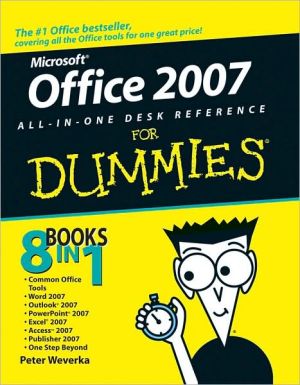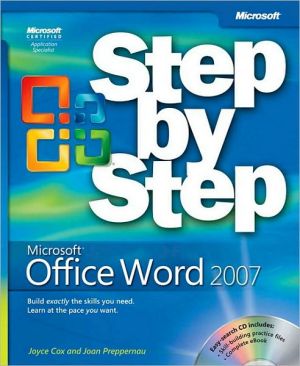Perfect Pages
FOR AN UPDATE ARTICLE ON WORD 2007, READERS OF THIS BOOK SHOULD VISIT THE AUTHOR'S WEB SITE\ Nowadays, new technologies and services have made it easier than ever to publish your book, but there's one question you may still face: Do I need an expensive page layout program, or can I just use a word processor like Microsoft Word? With this book as guide, you'll soon be producing pages from Word that no reviewer will scoff at.\ /////////////////////////////////////////////////\ Aaron Shepard is...
Search in google:
Nowadays, new technologies and services have made it easier than ever to publish your book. But if you mean to design it yourself, you may face an important question: Do I need an expensive page layout program like Adobe InDesign, Adobe PageMaker, or QuarkXPress? Or can I instead use a word processor like Microsoft Word? If you know the basic principles of typography and book design-as well as the capabilities of your program-there's no reason a book done in Word should look less than professional. With this book as guide, you'll soon produce pages no reviewer will scoff at. Topics in this book include speeding up Word, avoiding file corruption, optimizing Word for print, handling custom page sizes, structuring your book with Word sections, using templates, using styles, using print vs. typewriter typography, choosing fonts, formatting your text, setting up hyphenation, smoothing your paragraphs, controlling page endings, evening your pages, preparing and placing graphics, inserting text boxes, adding borders and backgrounds, using alignment aids, producing printouts for scanning, preparing PDF files, converting color for print, placing crop marks, creating a simple book cover, and many more.
One of the most important questions a self publisher may face is: Do I need an expensive page layout program like Adobe InDesign, Adobe PageMaker, or QuarkXPress to produce a commercial book? Or can I manage with a word processor like Microsoft Word?Ask a publishing professional, and you will usually be told that you need a page layout program. Yet many upstart and even established publishers use Word instead. Most of my own books are produced in Word-including this one.It's true that Word lacks some advanced typographic features found in page layout programs. But if you know the basic principles of typography and book design and how to apply them, there's no reason a book you produce in Word should look less than professional. And if you don't know those principles, then a page layout program won't help you!Besides that, a word processor can actually be the better choice for some books. Page layout programs excel at composing pages with substantial graphics and sophisticated layout, such as for magazines or textbooks. But they can be clumsy when handling long and complex text-which is just what Word does well.Also, use of a page layout program makes more sense when the book designer is someone other than the author. For an author-designer-publisher, using one program for both writing and layout can simplify and speed your work. This is especially true if your book will need revisions or updates. A program like Word can automatically adjust for text additions and deletions in such a way that little or no manual reformatting is required.Word is seldom surpassed in its abilities to create automatic tables of contents, indexes, and cross-references. It's also excellent in its automatic handling of footnotes and endnotes-something a page layout program might not even attempt.Finally, some publishers who have tried both Word and a page layout program will tell you that the page layout program may produce slightly better text, but that Word can more than make up for it with easier, speedier formatting.In the past, one good reason to avoid Word for publishing was that its printer files played well only with desktop printers, not with printing presses. But Adobe Acrobat and its Portable Document Format (PDF) have changed that. Today's digital presses easily handle PDF files created by Acrobat and other programs from Word documents.Even better is to come. At this writing, Microsoft is revamping its word processor, with the first fruits due in 2006. Upcoming versions will feature built-in export to PDF, so that programs like Acrobat should be optional.Also slated for development is the handling of graphics in CMYK, the full-color mode preferred by printing presses. This new capability should finally make Word suited to commercial color printing.In this book, I'll tell you how to produce pages that no book reviewer will scoff at, and I'll offer other helpful tips as well on using Word. But, no, I will not tell you everything you'll need to know. If you're publishing with Word, you'll definitely want a good, comprehensive manual on your version.I also highly recommend that you get and read a copy of James Felici's The Complete Manual of Typography. In fact, that might be the most important tip you find here! Though I've done my best to give you the basics of book design and typography, Felici will give you many of the details.You'll also want to look at a multitude of commercially published books for examples of typography and book design. See what works-and what doesn't! And while you probably won't want to exactly duplicate an existing book design, there's nothing wrong with using elements that appeal to you.This version of my book is based on Word 97-2003 for Windows, and on Word 2004 for the Mac. (If you're still on Mac OS 9 and need to use Word 98 or 2001, please ask me for a free copy of my earlier ebook Books, Typography, and Microsoft Word.) Word's typographic features do not change often, but its interface does-and 2006 will bring the biggest changes in over a decade. If you're on a Word version that doesn't show a command or setting where I say it is, please use Word's Help function or your manual to find what you need. And if you discover an additional way to do something, consider it a bonus!Though I can't offer private technical assistance for Word, I welcome your feedback to help me improve future editions of this book. Please bring your comments and suggestions to Aaron Shepard's Publishing Page on the Web. And while you're there, be sure to sign up for my email bulletin to receive notice of updates.
About This BookWorking with Word #1: Choosing a Version1 ~ MANAGING WORDManaging UpdatesManaging Options or PreferencesManaging the WorkspaceManaging Automatic ChangesManaging FeaturesManaging Old FilesManaging SafetyManaging MemoryWorking with Word #2: Using Views2 ~ FORMATTING YOUR DOCUMENTSetting Up Your FileSetting Your Page SizeSetting Your Page MarginsSetting Up SectionsSetting Up Headers and FootersSetting Up ColumnsWorking with Word #3: Using Templates3 ~ TYPESETTING YOUR TEXTUsing Print PunctuationUsing Print SymbolsUsing Print EmphasisUsing Print SpacesUsing Print ParagraphsUsing Print Vertical Spacing4 ~ FORMATTING YOUR TEXTChoosing Your FontsChoosing Your Font SizeChoosing Your Vertical SpacingControlling Horizontal SpacingControlling JustificationControlling HyphenationControlling Page EndingsWorking with Word #4: Using Styles5 ~ PERFECTING YOUR TEXTFixing LetterspacingFixing Line EndingsFixing ParagraphsFixing Page Endings6 ~ HANDLING SPECIAL TEXTHandling Headers and FootersHandling Page NumberingHandling Footnotes and EndnotesHandling Automated TextHandling Lists7 ~ HANDLING GRAPHICSPreparing GraphicsPlacing Graphics8 ~ ENHANCING YOUR LAYOUTAdding TablesAdding Text Boxes and FramesAdding Borders and BackgroundsAdding OrnamentsWorking with Word #5: Using Alignment Aids9 ~ PREPARING FOR PRINTChoosing a Print ServiceCentering Your PagesPreparing Hard CopyPreparing Word FilesPreparing PDF FilesConverting Your ColorsPlacing Crop MarksChecking Your Work10 ~ CREATING A COVERDesigning a Simple CoverSetting Your Cover SizeSetting Your Cover MarginsHandling Cover TextHandling Cover GraphicsAdding a Bar CodePreparing Your Cover for PrintRESOURCESBooksWeb SitesNewsgroupsEmail Discussion ListsNewsletters








